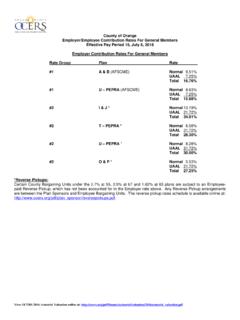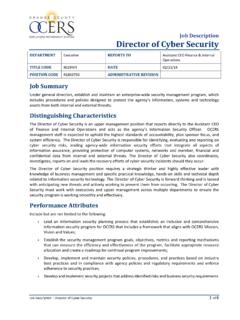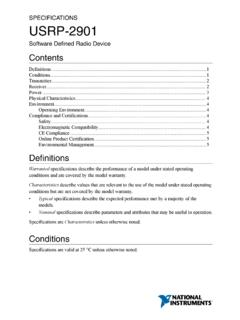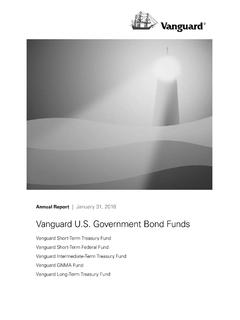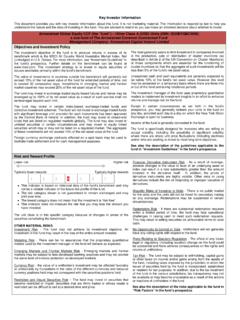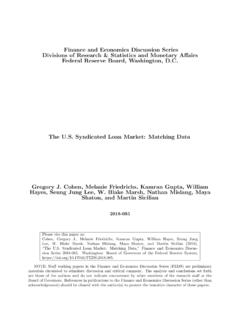Transcription of Investment Policy Statement - OCERS - Home
1 'I. ORANG E COUN T Y. EMPLOYEES RETIREMENT SYST EM OCERS Board Policy Investment Policy Statement Introduction The Orange County Employees Retirement System ( OCERS ) was established in 1945 under the County Employees Retirement Law of 1937. OCERS exists to provide retirement, disability, and death benefits for qualified employees of Orange County and participating special districts. As provided by its charter, the Investment Committee ( Committee ) governs OCERS ' Investment program. The Committee has the sole authority over the Investment portfolio and may delegate responsibilities to the Investment staff and external advisors. The purpose of the Investment Policy Statement is to assist the Committee in effectively supervising, monitoring, and evaluating the Investment of the system's assets by: Stating the OCERS Investment Beliefs Establishing the Investment goals, objectives, and risk tolerance of the system.
2 Defining asset class allocations, targets and ranges. Creating oversight standards for Policy implementation. Setting performance objectives and measurement criteria. Investment Beliefs Diversification - Diversification results in a more efficient portfolio and can help to mitigate a wide variety of risks. Over diversification should be avoided, and investments must be sizable enough to impact the overall portfolio. Costs - Expensive active management must be evaluated in an effort to ensure that OCERS will be commensurately compensated for the higher fees. Whenever possible, passive alternatives should be utilized, and performance fees should be accompanied by hurdle rates. Additionally, OCERS believes in structuring active manager compensation to best align the managers' interests with those of OCERS .
3 Time Horizon - OCERS has a long-term Investment horizon of 20 years. Risk - An appropriate level of risk is necessary in order to achieve desired long-term Investment returns. Risk should be discussed in terms of balancing desired returns with tolerance for volatility, and risk should be evaluated based on OCERS ' capacity to recover from adverse market volatility. Since no single metric adequately conveys risk, OCERS will evaluate risk holistically, incorporating quantitative and qualitative assessments into management of the portfolio. Active vs. Passive - In markets where evidence suggests that security prices are efficiently set, passive (indexed) market strategies will be employed. In less efficiently priced markets, OCERS is comfortable with the thoughtful use of active management strategies.
4 Investment Policy Statement 1 of 13. Adopted Date May 11, 1992. Last Revised April 24, 2018. ORANG E COUN T Y. EMPLOYEES RETIREMENT SYST EM OCERS Board Policy Investment Policy Statement Private Markets/Illiquid Strategies - Private markets/illiquid strategies can add value when an appropriate illiquidity premium is expected to be captured. OCERS has the ability and risk tolerance to invest in illiquid strategies. Tactical vs. Strategic - A long-term strategic asset allocation should be adopted, and assets should be rebalanced regularly. However, in times of extreme market dislocations, tactical adjustments should be considered. OCERS believes that, if properly compensated for the risk, opportunistic investments could also benefit the portfolio.
5 Performance Evaluation - Performance should be evaluated over long periods of time in the context of the actuarial assumed rate of return, the Policy Benchmark, and relative to peers. The influence of the market environment should be taken into account when evaluating performance. Investment Goals and Objectives OCERS ' goal is to meet the promised retirement benefits due its members. OCERS invests the assets of the system solely for the benefit of plan participants and beneficiaries while minimizing employer contributions and Investment and administration costs. The long-term performance objective for the portfolio is to exceed the actuarially assumed rate of return net of fees and expenses, with a secondary objective of exceeding the return on an appropriate designated benchmark over a complete economic cycle and relevant longer periods, also net of fees and expenses.
6 Investment Policy Implementation Investment Horizon The Committee will periodically review the portfolio's alignment with the fund's pension liabilities. The Investment Policy and guidelines are based on an Investment horizon of 20 years. The Committee will consider both intermediate-term and longer-term Investment return horizons in formulating expected returns and assessing portfolio risk parameters. The system's strategic asset allocation is based on this longer-term perspective. Fluctuations of Investment results in the interim should be viewed with an appropriate perspective. Risk Tolerance Investment opportunities in various asset classes have differing risk and return expectations. In general, investments with higher expected returns involve a higher level of risk.
7 The Committee recognizes that some level of risk must be assumed to achieve the system's long-term Investment objectives. The Committee shall establish risk tolerance parameters for the overall portfolio and its major asset classes. The Committee will attempt to achieve its Investment return objective with an appropriate level of risk using an efficient combination of investable assets. Investment Policy Statement 2 of 13. Adopted Date May 11, 1992. Last Revised April 24, 2018. 'I. ORANG E COUN T Y. EMPLOYEES RETIREMENT SYST EM OCERS Board Policy Investment Policy Statement Liquidity Needs Sufficient liquidity must be maintained to pay benefits and expenses. Investment income and contributions are expected to exceed projected benefit payments and expenses on an annual basis for the foreseeable future, making it possible to invest a reasonable portion of the portfolio in illiquid investments.
8 The liquidity horizon shall be reviewed each time asset allocations and expected return projections are revised. Asset Allocation The Committee has adopted a strategic asset allocation plan based upon the fund's projected actuarial liabilities and liquidity needs, the Committee's risk tolerances and the risk/return expectations for various asset classes. This asset allocation plan seeks to optimize long-term returns for the level of risk that the Committee considers appropriate. Since projected liability and risk/return expectations will change over time, the Committee will conduct a periodic review of the asset allocation plan to maintain an optimal allocation, and may also revise the asset allocation in response to significantly changing market conditions that have affected valuations and forward-looking expected returns of asset classes.
9 At a minimum, a formal asset allocation review is required every three years. The asset allocation study will detail the optimal Investment structure and strategy, including discussion of geography, style, size, factor, active/passive biases, long-only vs. long/short preferences and any other execution drivers that may assist OCERS in achieving its goals. The current strategic asset allocation targets and ranges are detailed in Appendix 1. Rebalancing The Chief Investment Officer ( CIO ) will monitor the asset allocation and rebalance to the approved ranges as and when necessary. Any such rebalancing will be reviewed with the Committee in the subsequent monthly report. Whenever practicable, major shifts in funds will be discussed in advance with the Committee.
10 The CIO may also recommend dynamic or tactical rebalancing strategies as appropriate under various market conditions, if appropriate and prudent. Performance Objectives The expected and actual Investment returns of the total fund will depend on the asset allocation targets, the mix of Investment styles within asset classes, and individual manager performance. Therefore, performance objectives have been set at three levels: total fund, asset class, and individual portfolios. Investment Policy Statement 3 of 13. Adopted Date May 11, 1992. Last Revised April 24, 2018. ORANG E COUN T Y. EMPLOYEES RETIREMENT SYST EM OCERS Board Policy Investment Policy Statement Total Fund Meet or exceed the actuarial rate of interest which has taken into account expected composite portfolio returns.



